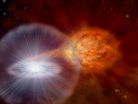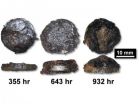(Press-News.org) TEMPE, Ariz. - The Universe is home to a variety of exotic objects and beautiful phenomena, some of which can generate almost inconceivable amounts of energy. ASU Regents' Professor Sumner Starrfield is part of a team that used the Large Area Telescope (LAT) onboard NASA's Fermi Gamma-ray Space Telescope satellite to discover very high energy gamma rays (the most energetic form of light) being emitted by an exploding star. The surprising discovery dispels the long-held idea that classical nova explosions are not powerful enough to produce such high-energy radiation.
In March 2010, scientists using the LAT reported a surprising discovery: detection of gamma rays that appeared to come from a nova, V407 Cygni. The LAT, in orbit around the Earth, views ∼20% of the sky instantaneously and the entire sky every three hours. It is the most sensitive gamma-ray space telescope ever flown.
A nova is observed as a sudden, short-lived rapid increase in the brightness of an otherwise inconspicuous star. It results from runaway thermonuclear explosions that typically take place in a binary system on the surface of a white dwarf fueled by mass from a companion star. The outburst occurs when a white dwarf erupts in an enormous thermonuclear explosion. The explosion is equivalent to about 100,000 times the energy that the sun gives off every year. Unlike supernovas, novae do not result in the destruction of their stars.
Although novae produce bright optical events, they had not previously been considered as potential sources of high energy gamma rays since they are not predicted to accelerate particles to the required energies (very nearly the speed of light). Few cosmic marvels can accelerate particles to the energies required to generate gamma rays, billions of times more energetic than the type of light visible to our eyes. Researchers had expected and seen X-rays from the resulting waves of expanding gas in prior novae.
The finding overturned the notion that novae explosions lack the power to emit such high-energy radiation. Subsequently in June 2012, two more novae were detected with the LAT, Nova Sco 2012 and Nova Mon 2012, thus heralding novae as a new gamma-ray source class.
These findings are published in the August 1 issue of the journal Science with Teddy Cheung, an astrophysicist at the Naval Research Laboratory in Washington, as the lead author.
"This was a completely unexpected discovery and we still don't understand the cause," says computational astrophysicist Starrfield, a professor in the School of Earth and Space Exploration at ASU. "No one suspected novae were violent enough to be emitting at these very high energies. However, it now seems possible that a signification fraction – near 100% – of novae are gamma ray sources."
Origins unknown
The white dwarf star V407 Cyg lies 9,000 light-years away in the plane of our Milky Way galaxy. It erupted in a rare type of nova called a likely recurrent symbiotic nova, in which the companion star is a pulsating red giant star (about 500 times the size of the sun) blowing out a strong stellar wind. The explosion of the white dwarf occurs inside the atmosphere of the companion star.
Researchers suggested that the gamma rays in the nova were generated when the blast waves from the nova collided with the very dense winds from the red giant, something that doesn't appear in classical novae.
Although the LAT followed up on later optically bright classical novae, it saw nothing for two years, and the theory that V407 Cyg was a special case seemed confirmed. Then, in June 2012, two separate novae were seen in gamma rays: Nova Sco 2012 and Nova Mon 2012 both emitted detectable levels of gamma rays.
But Nova Sco 2012 and Nova Mon 2012 are classical novae accreting from small, nearby companions. There's no thick stellar wind to produce a shock like there is in V407 Cyg. So where are the gamma rays coming from?
The answer at the moment is: We don't know.
Although researchers can't yet explain how and why, what we do know is that novae can be gamma ray emitters and they are not as rare as originally suspected.
"We are puzzled and ongoing studies of possible causes are underway via computer modeling of the events," says Starrfield. "This exciting discovery is telling us something important about the explosions of classical novae but we don't, as yet, know what it means."
INFORMATION:
Fermi satellite detects gamma-rays from exploding novae
Surprising discovery dispels long-held idea that classical nova explosions are not violent enough to produce such high-energy radiation
2014-07-31
ELSE PRESS RELEASES FROM THIS DATE:
NASA sees Genevieve squeezed between 3 tropical systems
2014-07-31
The resurrected Tropical Depression Genevieve appears squeezed between three other developing areas of low pressure. Satellite data from NOAA and NASA continue to show a lot of tropical activity in the Eastern and Central Pacific Oceans on July 31.
NASA/NOAA's GOES Project at the NASA Goddard Space Flight Center in Greenbelt, Maryland has been kept busy, providing visible and infrared satellite imagery of the Eastern and Central Pacific Oceans. The project uses data from NOAA's GOES-West and GOES-East satellites to create images and animations. All four systems were captured ...
CU Denver study links self-identified ethnic labels to cultural values
2014-07-31
DENVER (July 31, 2014) – A recently released study by a researcher at the University of Colorado Denver and published in the Journal of Humanistic Counseling explores why people of Latin American descent self-identify using terms like Latina/o, Hispanic, and Chicana/o. Carlos Hipolito-Delgado, an associate professor in the School of Education & Human Development at the University of Colorado Denver, found a difference between preferred ethnic labels and how a person identifies with their cultural heritage and United States values.
An expert in ethnic identity development, ...
Carnegie Mellon chemists create nanofibers using unprecedented new method
2014-07-31
PITTSBURGH—Researchers from Carnegie Mellon University have developed a novel method for creating self-assembled protein/polymer nanostructures that are reminiscent of fibers found in living cells. The work offers a promising new way to fabricate materials for drug delivery and tissue engineering applications. The findings were published in the July 28 issue of Angewandte Chemie International Edition.
"We have demonstrated that, by adding flexible linkers to protein molecules, we can form completely new types of aggregates. These aggregates can act as a structural material ...
Groundbreaking research maps cultural history
2014-07-31
New research from Northeastern University has mapped the intellectual migration network in North America and Europe over a 2,000-year span. The team of network scientists used the birth and death locations of more than 150,000 intellectuals to map their mobility patterns in order to identify the major cultural centers on the two continents over two millennia.
In the new paper, to be published Friday in the journal Science, the researchers found how locations such as Rome, London, and Paris have emerged as cultural hubs as more intellectuals died in these cities than ...
NIST corrosion lab tests suggest need for underground gas tank retrofits
2014-07-31
A hidden hazard lurks beneath many of the roughly 156,000 gas stations across the United States.
The hazard is corrosion in parts of underground gas storage tanks—corrosion that could result in failures, leaks and contamination of groundwater, a source of drinking water. In recent years, field inspectors in nine states have reported many rapidly corroding gas storage tank components such as sump pumps. These incidents are generally associated with use of gasoline-ethanol blends and the presence of bacteria, Acetobacter aceti, which convert ethanol to acetic acid, a component ...
New bipartisan House bill draws on U-M health research
2014-07-31
ANN ARBOR—A new bill introduced in Congress with bipartisan support would allow Medicare to test a concept born from University of Michigan research, which could improve the health of patients with chronic illness while reducing what they spend on the medicines and tests they need most.
The bill, introduced last week by U.S. Reps. Diane Black and Earl Blumenauer, grew out of a decade of work by health policy researchers affiliated with the U-M's Institute for Healthcare Policy and Innovation. It would allow Medicare Advantage plans to use innovative "value-based" insurance ...
Parenting skills improve in ADHD parents with medication
2014-07-31
Parenting skills of adults with ADHD improve when their ADHD is treated with medication, according to Penn State College of Medicine researchers.
At least 25 percent of clinic-referred children with attention deficit/hyperactivity disorder have a parent with ADHD.
"Parents with ADHD are at increased risk to engage in problematic parenting techniques, including inconsistent disciplinary practices, making ineffectual commands and diminished use of praise," said James Waxmonsky, associate professor of psychiatry. "Having a parent with ADHD also decreases the chances that ...
The 'memory' of starvation is in your genes
2014-07-31
During the winter of 1944, the Nazis blocked food supplies to the western Netherlands, creating a period of widespread famine and devastation. The impact of starvation on expectant mothers produced one of the first known epigenetic "experiments" — changes resulting from external rather than genetic influences — which suggested that the body's physiological responses to hardship could be inherited. The underlying mechanism, however, remained a mystery.
In a paper published recently in the journal Cell, Dr. Oded Rechavi, Dr. Leah Houri-Ze'ev and Dr. Sarit Anava of Tel ...
NASA sees Tropical Storm Halong move northwest of Guam
2014-07-31
NASA's Tropical Rainfall Measuring Mission or TRMM Satellite passed over Guam as heavy rain fell over the island while Tropical Storm Halong's center passed just to the north of the island.
The TRMM satellite flew above tropical storm Halong on July 31, 2014 at 0904 UTC (August 1, 2014 at 7:04 p.m. local time, Guam).
At NASA's Goddard Space Flight Center in Greenbelt, Maryland TRMM data was used to create a rainfall analysis. The analysis derived TRMM's Microwave Imager (TMI) and Precipitation Radar (PR) data was overlaid on a visible/infrared image from Japan's MTSAT-2 ...
Asteroid attacks significantly altered ancient Earth
2014-07-31
TEMPE, Ariz. – New research shows that more than four billion years ago, the surface of Earth was heavily reprocessed – or mixed, buried and melted – as a result of giant asteroid impacts. A new terrestrial bombardment model based on existing lunar and terrestrial data sheds light on the role asteroid bombardments played in the geological evolution of the uppermost layers of the Hadean Earth (approximately 4 to 4.5 billion years ago).
An international team of researchers published their findings in the July 31, 2014 issue of Nature.
"When we look at the present day, ...
LAST 30 PRESS RELEASES:
New study shows how the spleen helps the immune system accept a transplant
New Mayo Clinic study advances personalized prostate cancer education with an EHR-integrated AI agent
Researchers identify novel therapeutic target to improve recovery after nerve injury
Microbes in breast milk help populate infant gut microbiomes
Reprogramming immunity to rewrite the story of Type 1 diabetes
New tool narrows the search for ideal material structures
Artificial saliva containing sugarcane protein helps protect the teeth of patients with head and neck cancer
Understanding the role of linear ubiquitination in T-tubule biogenesis
Researchers identify urban atmosphere as primary reservoir of microplastics
World’s oldest arrow poison – 60,000-year-old traces reveal early advanced hunting techniques
Bristol scientists discover early sponges were soft
New study uncovers how rice viruses manipulate plant defenses to protect insect vectors
NSF–DOE Vera C. Rubin Observatory spots record-breaking asteroid in pre-survey observations
Ribosomal engineering creates “super-probiotic” bacteria
This self-powered eye tracker harnesses energy from blinking and is as comfortable as everyday glasses
Adverse prenatal exposures linked to higher rates of mental health issues, brain changes in adolescents
Restoring mitochondria shows promise for treating chronic nerve pain
Nature study identifies a molecular switch that controls transitions between single-celled and multicellular forms
USU chemists' CRISPR discovery could lead to single diagnostic test for COVID, flu, RSV
Early hominins from Morocco reveal an African lineage near the root of Homo sapiens
Small chimps, big risks: What chimps show us about our own behavior
We finally know how the most common types of planets are created
Thirty-year risk of cardiovascular disease among healthy women according to clinical thresholds of lipoprotein(a)
Yoga for opioid withdrawal and autonomic regulation
Gene therapy ‘switch’ may offer non-addictive pain relief
Study shows your genes determine how fast your DNA mutates with age
Common brain parasite can infect your immune cells. Here's why that's probably OK
International experts connect infections and aging through cellular senescence
An AI–DFT integrated framework accelerates materials discovery and design
Twist to reshape, shift to transform: Bilayer structure enables multifunctional imaging
[Press-News.org] Fermi satellite detects gamma-rays from exploding novaeSurprising discovery dispels long-held idea that classical nova explosions are not violent enough to produce such high-energy radiation






